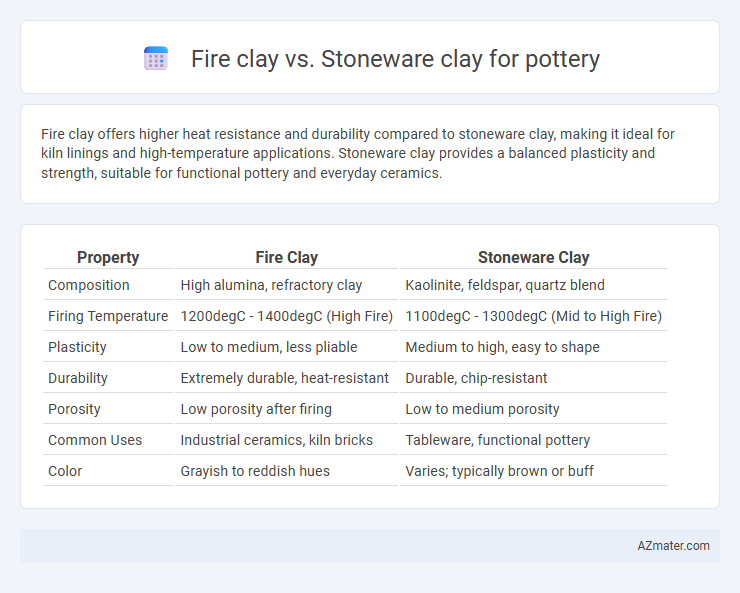Fire clay offers higher heat resistance and durability compared to stoneware clay, making it ideal for kiln linings and high-temperature applications. Stoneware clay provides a balanced plasticity and strength, suitable for functional pottery and everyday ceramics.
Table of Comparison
| Property | Fire Clay | Stoneware Clay |
|---|---|---|
| Composition | High alumina, refractory clay | Kaolinite, feldspar, quartz blend |
| Firing Temperature | 1200degC - 1400degC (High Fire) | 1100degC - 1300degC (Mid to High Fire) |
| Plasticity | Low to medium, less pliable | Medium to high, easy to shape |
| Durability | Extremely durable, heat-resistant | Durable, chip-resistant |
| Porosity | Low porosity after firing | Low to medium porosity |
| Common Uses | Industrial ceramics, kiln bricks | Tableware, functional pottery |
| Color | Grayish to reddish hues | Varies; typically brown or buff |
Introduction to Fire Clay and Stoneware Clay
Fire clay is a highly refractory material known for its heat resistance and durability, making it ideal for pottery requiring high-temperature firing. Stoneware clay, composed primarily of feldspar, silica, and kaolin, offers substantial plasticity and strength, resulting in dense, durable ceramic ware after firing between 1,200degC and 1,300degC. Both clays differ in composition and firing characteristics, influencing the texture, color, and functional properties of the final pottery pieces.
Key Differences Between Fire Clay and Stoneware Clay
Fire clay contains higher alumina and silica content, making it more refractory and resistant to high temperatures compared to stoneware clay. Stoneware clay exhibits greater plasticity and is easier to shape, offering a smoother texture suitable for functional pottery. Fire clay's coarse grain results in a more porous and dense final product, whereas stoneware clay fires to a vitrified, non-porous finish ideal for everyday use.
Composition and Mineral Content
Fire clay consists primarily of kaolinite and high alumina content, providing excellent heat resistance and durability in pottery applications. Stoneware clay contains a balanced mix of kaolinite, quartz, and feldspar, offering plasticity and strong vitrification at high firing temperatures. The higher alumina and silica in fire clay enhance thermal shock resistance, while stoneware's mineral composition allows for a more versatile range of textures and finishes.
Plasticity and Workability
Fire clay exhibits high plasticity, allowing potters to shape intricate forms with ease, making it ideal for detailed work and hand-building techniques. Stoneware clay has moderate plasticity but offers superior workability due to its balanced texture and smooth consistency, which facilitates wheel throwing and consistent shaping. Both clays mature at high temperatures, but fire clay's plastic nature enhances its versatility in creating durable, heat-resistant pottery.
Firing Temperatures and Techniques
Fire clay typically fires at a higher temperature range of 1200degC to 1400degC, making it suitable for stoneware and refractory applications, while stoneware clay usually matures between 1100degC and 1300degC. Fire clay's high alumina content enhances its thermal shock resistance, allowing it to withstand intense kiln atmospheres and reduction firing techniques often used in high-fire pottery. Stoneware clay, with its balanced composition, supports versatile firing methods including oxidation and reduction, producing durable ceramics with varying textures and finishes.
Durability and Strength of Finished Pieces
Fire clay exhibits exceptional durability and strength due to its high refractory properties, making it ideal for fireproof and heat-resistant pottery. Stoneware clay also provides significant strength and durability, with a dense, non-porous body that withstands everyday use and thermal shock. Fire clay typically offers superior resistance to extreme temperatures, while stoneware balances toughness with versatility for functional wares.
Glaze Compatibility and Surface Effects
Fire clay offers superior glaze compatibility due to its high refractory properties, allowing it to withstand higher firing temperatures without warping, which is ideal for intricate glaze finishes. Stoneware clay features a denser and smoother surface that interacts well with a wide range of glazes, promoting vibrant colors and glossy textures. The choice between fire clay and stoneware clay directly impacts the final glaze effect, with fire clay enhancing texture retention and stoneware providing a more refined, durable surface.
Ideal Uses in Pottery and Ceramic Arts
Fire clay is ideal for sculptural ceramics and functional pottery requiring high thermal resistance, such as fire bricks and kiln furniture, due to its ability to withstand extreme heat without cracking. Stoneware clay is preferred for durable, everyday pottery like bowls, plates, and mugs, offering a balance of plasticity, vitrification, and strength suitable for both wheel throwing and hand-building. Stoneware's dense, non-porous finish after firing makes it ideal for functional ware, while fire clay's refractory properties serve specialized applications in ceramics exposed to high temperatures.
Cost and Availability Comparison
Fire clay typically costs more due to its high refractory properties and specialized processing, making it less widely available than stoneware clay, which is commonly found in most pottery supply stores at lower prices. Stoneware clay is more accessible for beginners and casual potters because of its abundance and affordability, whereas fire clay is favored in industrial or high-temperature ceramic applications where durability justifies the higher expense. The price difference can significantly impact project budgets, especially for large-scale or frequent pottery production.
Choosing the Best Clay for Your Pottery Projects
Fire clay offers high resistance to heat and thermal shock, making it ideal for pottery requiring durability and strength, especially in kiln-fired projects. Stoneware clay provides a versatile, durable finish with good plasticity, perfect for functional pottery like dishes and mugs due to its combination of strength and workability. Choosing between fire clay and stoneware clay depends on the specific needs of your pottery project, focusing on thermal resistance for fire clay and everyday usability and aesthetic appeal for stoneware.

Infographic: Fire clay vs Stoneware clay for Pottery
 azmater.com
azmater.com